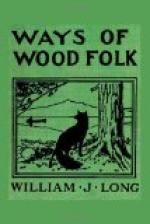With all their caution,—and they are very good weather prophets, knowing the times of tides and the approach of storms, as well as the days when fresh water freezes,—they sometimes get caught. Once I found a flock of five in great distress, frozen into the thin ice while sleeping, no doubt, with heads tucked under their wings. At another time I found a single bird floundering about with a big lump of ice and mud attached to his tail. He had probably found the insects plentiful in some bit of soft mud at low tide, and stayed there too long with the thermometer at zero.
Night is their feeding time; on the seacoast they fly in to the feeding grounds just at dusk. Fog bewilders them, and no bird likes to fly in rain, because it makes the feathers heavy; so on foggy or rainy afternoons they come in early, or not at all. The favorite feeding ground is a salt marsh, with springs and creeks of brackish water. Seeds, roots, tender grasses, and snails and insects in the mud left by the low tide are their usual winter food. When these grow scarce they betake themselves to the mussel beds with the coots; their flesh in consequence becomes strong and fishy.
When the first birds come in to the feeding grounds before dark, they do it with the greatest caution, examining not only the little pond or creek, but the whole neighborhood before lighting. The birds that follow trust to the inspection of these first comers, and generally fly straight in. For this reason it is well for one who attempts to see them at this time to have live decoys and, if possible, to have his blind built several days in advance, in order that the birds which may have been feeding in the place shall see no unusual object when they come in. If the blind be newly built, only the stranger birds will fly straight in to his decoys. Those that have been there before will either turn away in alarm, or else examine the blind very cautiously on all sides. If you know now how to wait and sit perfectly still, the birds will at last fly directly over the stand to look in. That is your only chance; and you must take it quickly if you expect to eat duck for dinner.
By moonlight one may sit on the bank in plain sight of his decoys, and watch the wild birds as long as he will. It is necessary only to sit perfectly still. But this is unsatisfactory; you can never see just what they are doing. Once I had thirty or forty close about me in this way. A sudden turn of my head, when a bat struck my cheek, sent them all off in a panic to the open ocean.
A curious thing frequently noticed about these birds as they come in at night is their power to make their wings noisy or almost silent at will. Sometimes the rustle is so slight that, unless the air is perfectly still, it is scarcely audible; at other times it is a strong wish-wish that can be heard two hundred yards away. The only theory I can suggest is that it is done as a kind of signal. In the daytime




